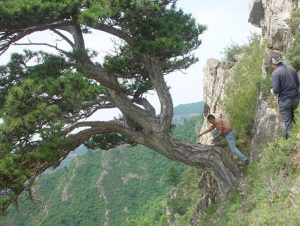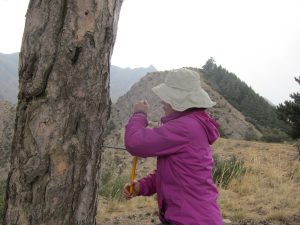Models implicate sulfate aerosol emissions as the culprit behind widespread drought cycles
15 May 2019
AGU press contact:
Liza Lester
+1 (202) 777-7494
[email protected]
Researcher contacts:
Yu Liu, Chinese Academy of Sciences
+86 13359291673
[email protected]
Steven Leavitt, University of Arizona, Tucson
[email protected] or [email protected]
WASHINGTON— Rainfall from the Asian summer monsoon has been decreasing over the past 80 years, a decline unprecedented in the last 448 years, according to a new study.
The new research used tree ring records to reconstruct the Asian summer monsoon back to 1566. The study, published in the AGU journal Geophysical Research Letters, found the monsoon has been weakening since the 1940s, resulting in regional droughts and hardships.

Two researchers balance on the edge of a cliff to sample an ancient pine tree. The team sought out the oldest trees on the western Loess Plateau in north central China, creating a nearly 450-year record of rainfall.
Credit: Liu Yu
The new research finds man-made atmospheric pollutants are likely the reason for the decline. The 80-year decline in the monsoon coincides with the ongoing boom in industrial development and aerosol emissions in China and the northern hemisphere that began around the end of World War II, according to the study’s authors.
Previous studies have looked at tree ring chronologies from this region but the new study, “surpasses [previous dendrochronology studies] in terms of the timespan covered and the number of trees involved,” said Steve Leavitt, a dendrochronologist at the University of Arizona in Tucson and a co-author of the new study. “We were able to gather nearly 450 years worth of tree ring data with clear annual resolution from an area where tree ring growth correlates very strongly with rainfall.”
Nearly half of the world’s population is affected by the Asian summer monsoon, which dumps the majority of the continent’s rainfall in a few short, torrential months. Summer rainfall has been declining in recent decades, influencing water availability, ecosystems and agriculture from India to Siberia.
Instrumental and observational records of monsoon strength and annual precipitation only go back about a hundred years. Long-term paleoclimate records are needed to help determine whether this decline is due to anthropogenic factors such as aerosol pollution or natural variation in the monsoon cycle.
Trees record hard times
The new study uses an ensemble of 10 tree ring chronologies collected from the western Loess Plateau in north central China to track precipitation trends over the last 448 years. In wetter years, trees tend to grow thicker rings and precipitation records can be gleaned by measuring the thickness and density of the individual layers.
“One of the primary advantages of using tree rings to study precipitation is the annual resolution and the exact dating,” Leavitt said.
The tree rings captured drought periods such as the one that struck in 1928 and 1929 that led to widespread famine where more than 500,000 people died in China alone. The findings were also cross-checked with Chinese historical records of locust plagues, which tend to occur in drought years, as well as previously published tree ring chronologies.

A researcher collects a core sample from a tree. Thinner growth rings correspond to times of drought.
Credit: Liu Yu
The new study found that the 80-year declining rainfall trend is unprecedented in the last 450 years, with more thin growth rings in the last 80 years than any other period. Prior to the 1940s, drought periods tended to be intermittent and shorter in duration with no other decades-long declines since 1566.
Several factors are thought to affect the strength of the Asian Summer Monsoon, including solar variability, volcanic eruptions and anthropogenic aerosols. The study’s authors used climate models to show sulfate aerosols – atmospheric pollutants that cause haze – are likely the dominant forcing agent controlling the decline of the Asian Summer Monsoon over the past 80 years.
The study is an important data point in the ongoing quest to better understand the past and future of the global monsoon systems that deliver much of the world’s precipitation, says Liviu Giosan, a paleoclimatologist at Woods Hole Oceanographic Institution in Massachusetts, who was not involved in the new study.
“Monsoons are notoriously difficult to model and predict due to the high degree of regional variability,” he said.
“To learn more about the future, we need to better understand the past,” Giosan said. “More of these kinds of studies that show [monsoon activity] over entire regions will help us better understand how the Asian Summer Monsoon functions as a whole, synoptically, over the entire continent.”
###
Founded in 1919, AGU is a not-for-profit scientific society dedicated to advancing Earth and space science for the benefit of humanity. We support 60,000 members, who reside in 135 countries, as well as our broader community, through high-quality scholarly publications, dynamic meetings, our dedication to science policy and science communications, and our commitment to building a diverse and inclusive workforce, as well as many other innovative programs. AGU is home to the award-winning news publication Eos, the Thriving Earth Exchange, where scientists and community leaders work together to tackle local issues, and a headquarters building that represents Washington, D.C.’s first net zero energy commercial renovation. We are celebrating our Centennial in 2019. #AGU100
Notes for Journalists
This paper is freely available through June 15. Journalists and public information officers (PIOs) can download a PDF copy of the article by clicking on this link: https://agupubs.onlinelibrary.wiley.com/doi/epdf/10.1029/2019GL082497
Journalists and PIOs may also request a copy of the final paper by emailing Liza Lester at [email protected]. Please provide your name, the name of your publication, and your phone number.
Neither the paper nor this press release is under embargo.
“Anthropogenic aerosols cause recent pronounced weakening of Asian Summer Monsoon relative to last four centuries”
Authors:
Yu Liu, The State Key Laboratory of Loess and Quaternary Geology, Institute of Earth Environment, Chinese Academy of Sciences, Xi’an, China; CAS Center for Excellence in Quaternary Science and Global Change, Chinese Academy of Sciences, Xi’an, China; Laboratory for Ocean Dynamics and Climate, Pilot Qingdao National Laboratory for Marine Science and Technology, Qingdao, China; Interdisciplinary Research Center of Earth Science Frontier (IRCESF) and Joint Center for Global Change Studies (JCGCS), Beijing Normal University, Beijing, China
Wenju Cai, Laboratory for Ocean Dynamics and Climate, Pilot Qingdao National Laboratory for Marine Science and Technology, Qingdao, China; Physical Oceanography Laboratory/CIMST, Ocean University of China and Qingdao National Laboratory for Marine Science and Technology, Qingdao, China; CSIRO Marine and Atmospheric Research, Aspendale, Victoria, Australia; The State Key Laboratory of Loess and Quaternary Geology, Institute of Earth Environment, Chinese Academy of Sciences, Xi’an, China
Huiming Song, The State Key Laboratory of Loess and Quaternary Geology, Institute of Earth Environment, Chinese Academy of Sciences, Xi’an, China; Laboratory for Ocean Dynamics and Climate, Pilot Qingdao National Laboratory for Marine Science and Technology, Qingdao, China
Kim M. Cobb, School of Earth and Atmospheric Sciences, Georgia Institute of Technology, Atlanta, Georgia, USA
Jianping Li, Laboratory for Ocean Dynamics and Climate, Pilot Qingdao National Laboratory for Marine Science and Technology, Qingdao, China; Physical Oceanography Laboratory/CIMST, Ocean University of China and Qingdao National Laboratory for Marine Science and Technology, Qingdao, China
Steven Leavitt, The Laboratory of Tree‐Ring Research, The University of Arizona, Tucson, Arizona, USA
Qiufang Cai, Laboratory for Ocean Dynamics and Climate, Pilot Qingdao National Laboratory for Marine Science and Technology, Qingdao, China
Ruoshi Liu, School of Human Settlements and Civil Engineering, Xi’an Jiaotong University, Xi’an, China
Benjamin Ng, CSIRO Marine and Atmospheric Research, Aspendale, Victoria, Australia
Paolo Cherubini, Swiss Federal Institute for Forest, Snow and Landscape Research, Birmensdorf, Switzerland
Ulf Buentgen, Department of Geography, University of Cambridge, UK; Swiss Federal Institute for Forest, Snow and Landscape Research, Birmensdorf, Switzerland; Global Change Research Centre and Masaryk University, Brno, Czech Republic
Yi Song, The State Key Laboratory of Loess and Quaternary Geology, Institute of Earth Environment, Chinese Academy of Sciences, Xi’an, China
Guojian Wang, Laboratory for Ocean Dynamics and Climate, Pilot Qingdao National Laboratory for Marine Science and Technology, Qingdao, China; CSIRO Marine and Atmospheric Research, Aspendale, Victoria, Australia
Ying Lei, The State Key Laboratory of Loess and Quaternary Geology, Institute of Earth Environment, Chinese Academy of Sciences, Xi’an, China
Libin Yan, The State Key Laboratory of Loess and Quaternary Geology, Institute of Earth Environment, Chinese Academy of Sciences, Xi’an, China
Qiang Li, The State Key Laboratory of Loess and Quaternary Geology, Institute of Earth Environment, Chinese Academy of Sciences, Xi’an, China; Laboratory for Ocean Dynamics and Climate, Pilot Qingdao National Laboratory for Marine Science and Technology, Qingdao, China
Yongyong Ma, Shaanxi Meteorological Observatory, Xi’an, China
Congxi Fang, The State Key Laboratory of Loess and Quaternary Geology, Institute of Earth Environment, Chinese Academy of Sciences, Xi’an, China
Junyan Sun, The State Key Laboratory of Loess and Quaternary Geology, Institute of Earth Environment, Chinese Academy of Sciences, Xi’an, China
Xuxiang Li, School of Human Settlements and Civil Engineering, Xi’an Jiaotong University, Xi’an, China
Deliang Chen, Regional Climate Group, Department of Earth Sciences, University of Gothenburg, Gothenburg, Sweden
Hans Wilhelm Linderholm, Regional Climate Group, Department of Earth Sciences, University of Gothenburg, Gothenburg, Sweden